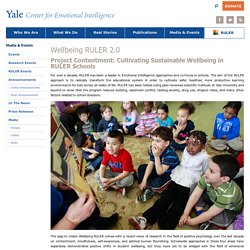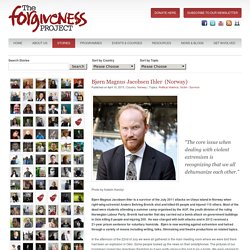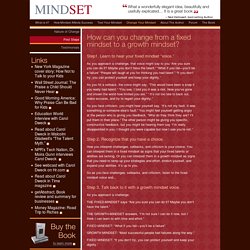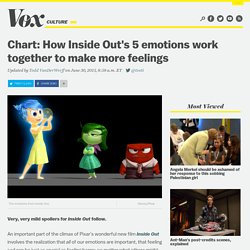

Moshi: The Sleep & Mindfulness App for Kids. (8) "Why Zebras Don't Get Ulcers: Stress and Health" by Dr. Robert Sapolsky. Edutopia. Recently, the Aspen Institute released “The Practice Base for How We Learn: Supporting Students’ Social, Emotional, and Academic Development,” which contains several statements of practice for integrating these different aspects of learning. Before You Feel Pressure - WATCH THIS. Before You Give Up Watch This - Motivation with Jay Shetty. About Emotional Agility — Susan David, Ph.D. Get unstuck, embrace change, and thrive in work and life The way we navigate our inner world – our everyday thoughts, emotions, and self-stories – is the single most important determinant of our life success.

It drives our actions, careers, relationships, happiness, health; everything. For example: Do we let our self-doubts, failings, shame, fear, or anger hold us back? Can we be determined, persevering toward key life goals, but just as importantly, have the insight and courage to recognize when these goals are not serving us, and adapt? Wellbeing RULER 2.0. Project Contentment: Cultivating Sustainable Wellbeing in RULER Schools For over a decade, RULER has been a leader in Emotional Intelligence approaches and curricula in schools.

The aim of the RULER approach is to radically transform the educational system in order to cultivate safer, healthier, more productive learning environments for kids across all walks of life. RULER has been tested using peer-reviewed scientific methods at Yale University and beyond to show that the program reduces bullying, classroom conflict, testing anxiety, drug use, dropout rates, and many other factors related to school stressors.
The leap to create Wellbeing RULER comes with a recent wave of research in the field of positive psychology over the last decade on contentment, mindfulness, self-awareness, and optimal human flourishing. The goal of Wellbeing RULER is to create a leading approach to social and emotional learning that directly bridges emotional intelligence and wellbeing in schools nationwide. Dr. My.happify. Amazing Things Happen. Social-Emotional Learning: What It Is and Why It Matters.
Lesson about diversity/social & emotional issues by studying son. Educating and empowering girls. Gratitude. Bullying. SMC Education Blog — Girls and Their Frenemies. RSA Short Brene Brown Gobblynne. Bjørn Magnus Jacobsen Ihler (Norway) - Forgiveness Project. Photo by Katalin Karolyi Bjørn Magnus Jacobsen Ihler is a survivor of the July 2011 attacks on Utøya island in Norway when right-wing extremist Anders Behring Breivik shot and killed 69 people and injured 110 others.

Most of the dead were students attending a summer camp organised by the AUF, the youth division of the ruling Norwegian Labour Party. Breivik had earlier that day carried out a bomb attack on government buildings in Oslo killing 8 people and injuring 209. He was charged with both attacks and in 2012 received a 21-year prison sentence for voluntary homicide. Gill Hicks (England) - Forgiveness Project. Photo by Brian Moody On 7th July 2005, 52 people died and many were severely injured and maimed, by suicide bombers attacking London’s transport system.

On a Piccadilly line underground train between Kings Cross and Russell Square stations, Australian-born Gill Hicks miraculously survived but lost both her legs due to the explosion. Gill’s memoir, One Unknown, was published in 2008. For more information please see: www.bethebridge.co. Couple Live Map. 16 Guidelines. 16 Guidelines “I have been implementing the 16 Guidelines in our classroom over the past three years.

During this time, I have noticed that the children’s emotional and social awareness has been greatly enhanced. They have become more aware of their daily interactions with their peers and can often be heard reminding one another of the Guidelines through out the day.” - Linda Manazzone, early school educator, McMaster Children’s Centre preschool program, Ontario, Canada The 16 Guidelines programme provides a simple, robust and flexible framework for developing empathy, compassion and resilience in daily life, suitable for both educational curricula and for personal and professional development.
The programme offers a range of practical tools and resources designed to promote reflection on the way we think, speak, act, and find meaning in life, presented through a mixture of exercises, group work and discussion. IO_Activity_1. Remove labels this Ramadan Growth Mindset Development. Pantene. If It Were My Home. School's trade project will help Nepal. Last updated 10:31, June 9 2015 Rose Cawley / Fairfax NZ The With One Loaf kids now want to sell their sleepout and put the money towards building houses in earthquake stricken Nepal.

Education Week. How can you change from a fixed mindset to a growth mindset? Step1.

Learn to hear your fixed mindset “voice.” As you approach a challenge, that voice might say to you “Are you sure you can do it? Maybe you don’t have the talent.” Michael Jordan Commercial - "Failure" Jennifer Bricker. What’s Going on Inside the Brain Of A Curious Child? By Maanvi Singh, NPR How does a sunset work?

We love to look at them, but Jolanda Blackwell wanted her 8th graders to really think about them, to wonder and question. So Blackwell, who teaches science at Oliver Wendell Holmes Junior High in Davis, Calif., had her students watch a video of a sunset on YouTube as part of a physics lesson on motion. “I asked them: ‘So what’s moving? And why?
'” Once she got the discussion going, the questions came rapid-fire. Students asking questions and then exploring the answers. Chart: How Inside Out's 5 emotions work together to make more feelings. Very, very mild spoilers for Inside Out follow.

An important part of the climax of Pixar's wonderful new film Inside Out involves the realization that all of our emotions are important, that feeling sad can be just as crucial as feeling happy, no matter what others might tell you. But the movie also reveals that as we get older, our emotions begin to blend together into newer, more complicated feelings. Early in the film, Riley — the 11-year-old girl whose mind serves as Inside Out's primary setting — is largely defined by very primal feelings. She's either all joy or all sadness. She's all anger, or all fear, or all disgust. 26 Random Acts of Kindness. Lifehack. How to Run an Ice Cream Shop: an "Excellence" Video. How to be a Breakdancer: An "Excellence" Video. Relationship-skills-video-lesson-plan. BillsTeachingNotes - GardnerMultIntell. Anti-Slavery Day - 18 October. Dragon Island April Fools Video Prank in Math Class. Educators - Teaching Children Philosophy.
Have you ever thought of using children's literature to teach philosophy to elementary school children?

It may surprise you to know that children's books often raise deep philosophical issues and that children love to think about them. This website contains all the materials that you need to lead philosophy discussions with your students. Ode to CAN read by Toni Colette. Be a Hero: Wisie Inspirational Video for Child Development. Austin's Butterfly: Building Excellence in Student Work - Models, Critique, and Descriptive Feedback.
Birmingham Grid for Learning - Multiple Intelligences (Secondary) It’s a Mistake Not to Use Mistakes as Part of the Learning Process. I recently heard a TED talk from Brian Goldman, a doctor who admits to having made mistakes. In very emotional language, he describes some costly emergency room mistakes, and then makes a strong case for changing the way that the medical profession addresses such things.
He believes that medicine will improve if doctors are free to discuss their mistakes, without judgment, allowing them to learn from each other. But, he continued, because doctors are judged by mistakes, they are too afraid to discuss them. Instead, they are often covered up, blamed on others, or ignored. Heart.jpg (JPEG Image, 3300 × 2550 pixels) - Scaled (31%) 9 year old discusses the meaning of life and the universe. How to teach mind mapping and how to make a mind map.
Mind mapping is a visual form of note taking that offers an overview of a topic and its complex information, allowing students to comprehend, create new ideas and build connections. Through the use of colors, images and words, mind mapping encourages students to begin with a central idea and expand outward to more in-depth sub-topics. Mind Map Example Definition of a Mind Map A mind map is a visual representation of hierarchical information that includes a central idea surrounded by connected branches of associated topics. Benefits of Mind Maps Help students brainstorm and explore any idea, concept, or problem Facilitate better understanding of relationships and connections between ideas and concepts Make it easy to communicate new ideas and thought processes Allow students to easily recall information Help students take notes and plan tasks Make it easy to organize ideas and concepts.
Failure: Seeds of Innovation. Lesson Focus Lesson focuses on how failure is part of the engineering process. Students work in teams and learn about many inventions and advances in engineering were brought about after a mistake or failure. Students research an example of such an innovation and develop a presentation related to how the tenacity of the engineer allowed him or her to move past a failure and into the realm of innovation. Students reflect on the value of moving on after a failure or setback, present the results of their research to the class, and provide examples of how the innovation they researched has impacted society -- only because the engineer didn't give up. Age Levels: Emotions and the Brain. Jubilee Project Short Film. What Do Emotions Have to Do with Learning?
Thinkstock When parents and teachers consider how children learn, it’s usually the intellectual aspects of the activity they have in mind. Sidney D’Mello would like to change that. The University of Notre Dame psychologist has been studying the role of feelings in learning for close to a decade, and he has concluded that complex learning is almost inevitably “an emotionally charged experience,” as he wrote in a paper published in the journal Learning and Instruction earlier this year. During the learning experiments described in his paper, he notes, the participating students reported being in a neutral state only about a quarter of the time.
The rest of the time, they were were experiencing lots of feelings: surprise, delight, engagement, confusion, boredom, frustration. Another counter-intuitive contention made by D’Mello is that even negative emotions can play a productive role in learning. Animated agents discussing scientific case studies. Related. Collaborative Mentoring Webinar Series. Inspire Her Mind. Science. Sample Lesson - Mindful Schools: Online Courses for Learning Mindfulness and Teaching Mindfulness to K-12 Children and Adolescents. 8 Uplifting Quotes For Discouraged Students. There are many reasons a student can lose focus in school. This Teacher Taught His Class A Powerful Lesson About Privilege. 8 Ways to Spot Emotional Manipulation.. and Free Ourselves From It. By Paul Lenda. Giving Good Praise to Girls: What Messages Stick. What’s Your Learning Disposition? How to Foster Students’ Mindsets. Now THIS Is A Commercial EVERY Woman Should See. I’m Blown Away! Kim Beale passionate soccer coach inspiring young people globally.
How to Get Students Ready for Learning. Learning and Change Networks: Connecting students with learning. Radio New Zealand : Search : Results. Sesame Street: Change The World. 40 Things I Want to Tell My Kids Before They’re Too Cool to Listen. Angela Lee Duckworth: The key to success? Grit. How Important is Grit in Student Achievement? Culture Teaching Strategies. How a Bigger Purpose Can Motivate Students to Learn.
How a Shoe Can Teach Responsibility. Travel Spotters CCTV Game : Our Work : Resources For Learning. Stuart Brown: Play is more than just fun. Please Don't Touch Me! {Dealing with Anxiety in Kids} Life beyond the dairy. Should you trust your first impression? - Peter Mende-Siedlecki. Easy Shoe-Tying Trick Makes The 'Bunny-Ear' Method Look Complicated.
Wendy Chung: Autism — what we know (and what we don’t know yet) Sesame Street: Mila Kunis: Include. Sesame Street: Bruno Mars: Don't Give Up. Did You Know? The Future Is Better Than You Think! A Wonderful Poster on Failure. No Fear. The Lost Art of Eye Contact. Emotional Intelligence Quiz. I am the Star (Kindergarten, Reading/Writing) 15 Sites That Show You The World in Real Time. Are you raising nice kids? A Harvard psychologist gives 5 ways to raise them to be kind. $20 Homeless Backpack Care Kit. Tim's Place Albuquerque: Service With A Smile. Social and Emotional Learning. The Science of Happiness - Calling to Say Thank You.